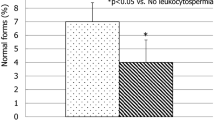Abstract
A total of 56 patients with haemospermia were reviewed. Twenty-four patients suffered from prolonged haemospermia for more than 1 month or recurrent haemospermia (refractory group). In 32 patients haemospermia disappeared within a month (non-refractory group). Patient age in the refractory group was significantly higher than that in the non-refractory group (p<0.05). Clinical symptoms other than haemospermia, white blood cell counts in the semen, expressed prostatic secretion and urine after prostatic massage, and transrectal ultrasonography findings were studied in both groups, with no significant differences found in any of these parameters. We concluded that, among these clinical findings, only patient age is a predictive factor for refractory haemosphermia.
Similar content being viewed by others
References
Fletcher, M. S., Herzberg, Z., Pryor, J. P.: The aetiology and investigation of haemospermia.Br. J. Urol., 53, 669 (1981).
Ganabathi, K., Chadwick, D., Feneley, R. C. L., Gingell, J. C.: Haemospermia?.Br. J. Urol., 69, 225 (1992).
Meares, E. M., Stamey, T. A.: Bacteriological localization patterns in bacterial prostatitis and urethritis.Invest. Urol., 5, 492 (1968).
Drach, G. W., Meares, E. M., Fair, W. R., Stamey, T. A.: Classification of benign diseases associated with prostatic pain: Prostatitis or prostatodynia?J. Urol., 120, 266 (1978).
Etherington, R. J., Clements, R., Griffiths, G. R., Peeling, W. B.: Transcretal ultrasound in the investigation of haemospermia.Clin. Radiol., 41, 175 (1990).
Meares, E. M. Jr.: Prostatitis: Review of pharmacokinetics and therapy.Rev. Infect. Dis., 4, 474 (1982).
Shortliffe, L. M. D., Sellers, R. G., Schachter, J.: The characterization of nonbacterial prostatitis: Search for an etiology.J. Urol., 148, 1461 (1992).
Koment, R. W., Poor, P. M.: Infection by human cytomegalovirus associated with chronic hematospermia.Urology, 22, 617 (1983).
Fuse, H., Sumiya, H., Ishii, H., Shimazaki, H.: Treatment of hemospermia caused by dilated Seminal vesicles by direct drug injection, guided by ultrasonography.J. Urol., 140, 991 (1988).
Stein, A. J., Prioleau, P. G., Catalona, W. J.: Adenomatous polyps of the rostatic urethra: A case of hematospermia.J. Urol., 124, 298 (1980).
Author information
Authors and Affiliations
Rights and permissions
About this article
Cite this article
Amano, T., Kunimi, K., Tokunaga, S. et al. Refractory haemospermia: Any predictive factors?. International Urology and Nephrology 27, 335–339 (1995). https://doi.org/10.1007/BF02564772
Received:
Issue Date:
DOI: https://doi.org/10.1007/BF02564772




